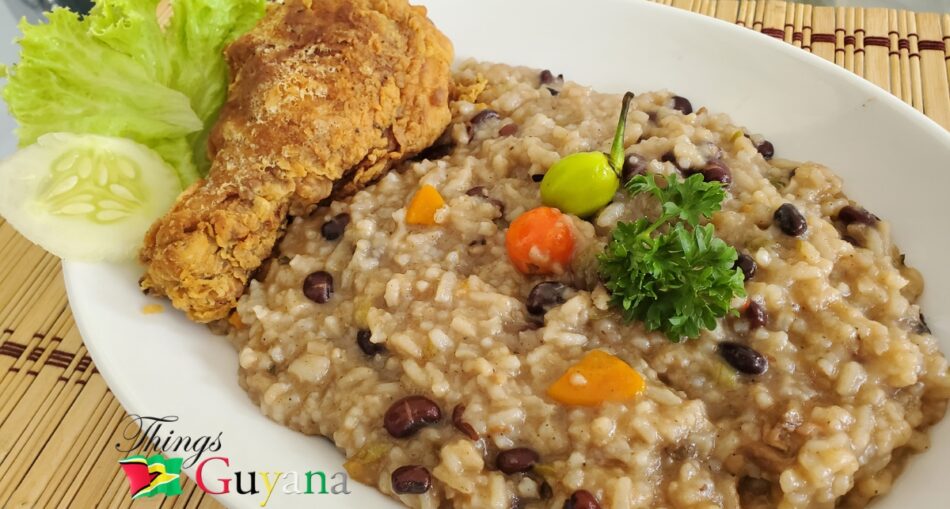Guyanese Cookup Rice stands as a cornerstone of the nation’s cuisine, a dish that transcends simple sustenance to embody the rich tapestry of Guyana’s history and cultural influences.1 This one-pot meal, characterized by its hearty combination of rice, meats, beans, and aromatic seasonings, is a versatile staple enjoyed by families for everyday dinners and as a centerpiece for special occasions.1 Whether prepared with tender marinated beef or other meats, the inclusion of beans and fresh aromatics makes it a satisfying and flavorful culinary experience.1 This traditional Guyanese recipe has earned its place as a beloved dish, celebrated for its comforting nature and ease of customization.1 Cookup Rice is an aromatic blend of long-grain rice simmered in creamy coconut milk, alongside a medley of beans, fresh vegetables, and indigenous herbs, each element contributing to its complex flavor profile and rich texture.2 As a one-pot wonder, it simplifies meal preparation while delivering a depth of flavor that speaks to the heart of Guyanese culinary heritage.1 This popular dish, a harmonious combination of peas, meat, rice, coconut milk, and aromatics, exemplifies the art of blending diverse ingredients into a unified and flavorful culinary creation.1 Indeed, Cookup Rice is more than just a meal in Guyana; it is a national dish that encapsulates the very essence of the country’s African heritage and the soul of its cuisine.2 Its widespread appeal and adaptability across various settings highlight its significance as a culinary cornerstone of Guyana.
Tracing the Origins
The history of Guyanese Cookup Rice is deeply intertwined with the transatlantic slave trade and the resourcefulness of the enslaved West Africans who were brought to Guyana.1 This iconic dish bears a direct lineage to West African culinary traditions, sharing notable similarities with dishes such as Waakye.1 Enslaved ancestors carried with them the practice of preparing one-pot meals featuring staples like black-eyed peas, meat, and rice, often consumed to commemorate significant occasions such as the New Year, with the hopeful anticipation of luck and prosperity.4 Facing the harsh realities of slavery and limited rations, these individuals ingeniously devised methods to create nourishing and flavorful meals from the scant provisions available to them, with Cookup Rice emerging as a testament to their culinary creativity and resilience.3 During slavery, Cookup Rice served as a means to combine small rations, transforming them into a more substantial meal, particularly during holidays when communities might have gathered.6 The culinary heritage of Cookup Rice also reveals an intersection with Indigenous Caribbean foodways.7 While enslaved Africans introduced ingredients like pigeon peas to the Caribbean, the cultivation of rice was already prevalent among Indigenous communities.7 This suggests a potential early exchange and fusion of agricultural practices and culinary techniques within the region, contributing to the unique character of Guyanese Cookup Rice. Notably, the earliest form of rice cultivation in the Caribbean involved African rice (oryza glaberrima), a grain brought by enslaved people originating from the “Rice Coast” of West Africa, where rice had been domesticated for millennia.8 The expertise in rice cultivation held by these enslaved individuals played a crucial role in establishing rice as a staple crop in the Caribbean. Cookup Rice, therefore, stands as a culinary embodiment of the historical interactions and adaptations of African and Indigenous food traditions in Guyana.
Cultural Tapestry of Cookup Rice
Cookup Rice is woven into the very fabric of Guyanese culture, holding significance that extends far beyond its role as a source of sustenance.9 It is a dish enjoyed throughout the year, often prepared outdoors over an open flame, evoking a sense of community and tradition.1 However, its importance is particularly pronounced on “Ole Year’s Night” (New Year’s Eve), where it is a tradition in almost every Guyanese home.9 Consuming Cookup Rice at the stroke of midnight as the first meal of the New Year is a deeply symbolic act, believed to usher in prosperity and ensure a year filled with abundance.1 The inclusion of black-eyed peas in this New Year’s tradition is particularly noteworthy, as these legumes are often associated with coins and represent the hope for wealth and good fortune in the coming year.1 Beyond the annual celebration, Cookup Rice is also a cherished staple for Saturday meals in many Guyanese households.4 This weekly tradition highlights the dish’s role as an easy and comforting meal to mark the end of the week.10 Furthermore, Cookup Rice is a go-to dish for family gatherings and when entertaining guests, as its one-pot nature makes it ideal for feeding large groups with relative ease.11 The communal aspect of sharing a pot of Cookup Rice fosters a sense of togetherness and strengthens social bonds within families and communities. In some instances, churches in Guyana have adopted the tradition of preparing Cookup Rice on Old Year’s Night, allowing congregants to share a meal after their New Year’s Eve services, further emphasizing the dish’s role in communal celebrations.12 Even on other significant days, such as Emancipation Day, Cookup Rice can be a part of the celebrations.13 The dish has also transcended its culinary function to become a metaphor for Guyanese national identity, representing the harmonious blending of various ethnicities and cultural practices that make up the nation.5 Ultimately, Cookup Rice stands as a cultural identifier, a dish that resonates deeply with the Guyanese people and embodies their shared heritage and traditions.12
The Heart of the Dish: A Traditional Recipe
The preparation of Guyanese Cookup Rice, while varying across households, generally follows a foundational recipe that highlights the key ingredients and techniques central to its character.
| Ingredient Category | Examples |
| Rice | Parboiled, long-grain white, medium-grain |
| Meats | Chicken, beef, pork, salted beef, pig tail, oxtail, ham, dried shrimp, fish |
| Legumes | Black-eyed peas, pigeon peas, red beans, chickpeas, split peas, mixed beans |
| Aromatics | Onion, garlic, scallions, thyme (fine leaf, broad leaf), hot peppers |
| Liquids | Coconut milk, water, chicken or beef broth |
| Optional Ingredients | Cassareep, brown sugar, vegetables (okra, pumpkin, carrots, cabbage), herbs |
The journey to creating a traditional pot of Cookup Rice typically begins with soaking dried peas or beans overnight to ensure they cook evenly.1 The chosen meats, often a combination of fresh and salted varieties, are then seasoned generously with a blend of herbs and spices, frequently including the vibrant green seasoning, and left to marinate for at least thirty minutes to allow the flavors to meld.1 Tougher cuts of meat, such as salted beef or pig tail, are often boiled separately to tenderize them and reduce their salt content.16 Similarly, dried beans are cooked until they reach a state of softness but remain intact.16 In a large, heavy-bottomed pot, the foundation of the dish is built by sautéing chopped onions and garlic in oil or rendered meat drippings until fragrant.1 Some variations involve browning the fresh meat at this stage to deepen its flavor.15 The washed rice, often parboiled for its resilience, is then added to the pot, followed by the cooked meats and beans, and the creamy richness of coconut milk.1 The ratio of coconut milk and water to rice is carefully judged to achieve the desired consistency, with some preferring a moister final product.17 Aromatic herbs like thyme, along with a whole or halved hot pepper for a touch of spice, are added to infuse the dish as it simmers.16 Optional ingredients, such as cassareep for color and a hint of bitterness, brown sugar for subtle sweetness, and an array of vegetables like okra, pumpkin, carrots, and cabbage, may also be incorporated at this point.1 Once all the ingredients are combined, the pot is brought to a boil, then the heat is significantly reduced to a low simmer, and the pot is tightly covered to allow the rice to cook gently and absorb all the flavorful liquids, typically taking around 20 to 30 minutes.15 After the rice has cooked and the liquid has been absorbed, it is customary to let the Cookup Rice rest, covered, for about 10 to 15 minutes before serving.4 Finally, the dish is served hot, often garnished with freshly chopped scallions or cilantro for a burst of freshness.14 Traditional accompaniments that complete the Guyanese Cookup Rice experience include sweet fried ripe plantains, crispy fried fish, a refreshing side salad, or a tangy achar (pickle).1
A Mosaic of Flavors: Variations Across Guyana
Guyanese Cookup Rice is not a rigid culinary creation but rather a dish that proudly showcases a wide spectrum of regional and familial adaptations, reflecting the diverse palates and available ingredients throughout Guyana.1 The preparation of Cookup Rice can differ markedly from one region to another and even within individual households, highlighting its deeply personal and adaptable nature.1 One notable point of divergence is the preference for the final texture, with some Guyanese favoring a “dry” Cookup Rice where the grains are distinct and separate, while others prefer a “wet” and more moist consistency.1 The choice of legumes also contributes significantly to the variety of Cookup Rice. While black-eyed peas are traditionally associated with Old Year’s Night, other popular options include the earthy pigeon peas, versatile red beans, hearty chickpeas, and the use of mixed beans for a more complex flavor profile.1 The selection of meats further amplifies the dish’s diversity. While chicken, beef, and pork are common choices, many variations feature salted meats like beef or pig tail for their intense savory flavor.4 Some recipes incorporate oxtail for its rich, gelatinous texture, while others might include dried shrimp to add a unique umami note.4 Fish, often fried to a crisp golden brown, is also a popular addition, either cooked into the dish or served as a topping.1 The array of vegetables and provisions that find their way into Cookup Rice further illustrates its adaptability. Okra, pumpkin, spinach, carrots, eddoes, yam, and even plantain can be included, depending on seasonal availability and individual preferences.14 Some less common but equally intriguing variations might even see the addition of fried rice, showcasing the fusion of culinary influences in Guyana.6 Across the Guianan region, similar one-pot rice dishes exist, such as the Surinamese Moksi Alesi, which features its own distinct set of ingredients, including salted fish and Dutch smoked sausage, highlighting how regional culinary traditions shape these fundamental rice-based meals.22 This rich tapestry of variations underscores that Cookup Rice is not a fixed entity but a dynamic and evolving dish that truly belongs to the people of Guyana.
Cookup Rice and the Rhythm of Life: Associations with Events and Traditions
Guyanese Cookup Rice is more than just a meal; it is deeply woven into the social and cultural fabric of the nation, marking significant occasions and reflecting cherished traditions.9 Its presence is most notable during “Ole Year’s Night,” the eve of the New Year, where it reigns supreme as the traditional dish in almost every Guyanese household.1 The act of preparing and consuming Cookup Rice as the first meal after midnight on New Year’s Eve is steeped in symbolism, believed to usher in a year of prosperity, good fortune, and ensure a constant supply of food in the home.1 The inclusion of black-eyed peas, with their resemblance to coins, further reinforces this association with wealth and abundance in the coming year.1 Beyond the annual New Year’s celebrations, Cookup Rice holds a special place as a customary meal for Saturdays across Guyana.4 This weekly tradition speaks to the dish’s role as a comforting and satisfying way to mark the end of the work week.10 Its practicality and heartiness also make Cookup Rice a popular choice for family gatherings and community events, where large pots of this one-pot wonder are often prepared to feed numerous people with ease.11 In some communities, churches have embraced the tradition of preparing Cookup Rice on Old Year’s Night, allowing members to partake in a communal meal after their New Year’s Eve services, underscoring the dish’s role in fostering togetherness during significant celebrations.12 Furthermore, Cookup Rice is also enjoyed on other important cultural days, such as Emancipation Day, highlighting its connection to broader aspects of Guyanese heritage.13
| Occasion | Typical Ingredients/Preparation Nuances | Symbolic Significance |
| Old Year’s Night | Often includes black-eyed peas and a variety of meats (beef, chicken, pork, salted meats, pig tail, oxtail, ham, dried shrimp). Freshly sourced ingredients are highly valued. Prepared to be ready by midnight and eaten as the first meal of the New Year. | Good luck, prosperity, ensuring food in the home throughout the New Year. Black-eyed peas symbolize wealth. |
| Saturdays | Can be made with whatever meats, beans/peas, and vegetables are readily available. Seen as an easy and comforting meal to mark the end of the week. | A hearty and satisfying meal for the end of the week. |
| Family Gatherings | Prepared in large quantities to feed many people. Often includes a mix of family members’ favorite meats and legumes. | Fosters togetherness and shared culinary experience. |
| Community Events | Practical and flavorful dish to serve at community gatherings and celebrations. Ingredients often depend on what is available and affordable for the event. | Promotes community spirit and shared cultural identity. |
| Emancipation Day | Can be included as part of the celebratory meals, reflecting the dish’s historical connection to African heritage. Specific ingredients might vary based on family or regional traditions for this particular day. | Honors African heritage and the history of resilience and freedom. |
The Significance of Ingredients
The unique character and flavor of Guyanese Cookup Rice are derived from a carefully chosen combination of key ingredients, each playing a vital role in the overall culinary experience. Rice, typically parboiled or long-grain white, serves as the substantial carbohydrate foundation of the dish, providing a satisfying base for the medley of other components.4 The creamy richness of coconut milk is a defining element, infusing the rice and other ingredients with a subtle sweetness and luxurious texture that distinguishes Cookup Rice within the broader category of rice and bean dishes.1 A variety of meats, often a combination of beef, chicken, pork, and salted options like beef or pig tail, contribute significant protein and depth of flavor to the dish.4 Salted meats, in particular, lend a unique savory dimension that is characteristic of many Guyanese stews and one-pot meals.4 Legumes, such as black-eyed peas, pigeon peas, and mixed beans, not only enhance the nutritional value of Cookup Rice but also provide a pleasant textural contrast to the rice and tender meats.1 Black-eyed peas hold a special symbolic significance, especially when Cookup Rice is prepared for New Year’s celebrations, representing luck, prosperity, and the hope for a bountiful year ahead.5 The aromatic foundation of Cookup Rice is built upon the essential flavors of onion, garlic, thyme (both the delicate fine leaf and the more robust broad leaf varieties), scallions, and the heat of Scotch bonnet or wiri wiri peppers.1 Marridman poke, also known as Thai basil, is considered by many to be a crucial herb for achieving the authentic and distinctive taste of Cookup Rice.21 The use of green seasoning, a vibrant blend of local herbs and spices, further enhances the flavor profile of the meats, adding layers of aromatic complexity.14 Finally, cassareep, a dark, viscous liquid derived from the cassava root, is a unique Guyanese ingredient that imparts a subtle bittersweet flavor and a rich, dark hue to the dish, also serving as a culinary link to Guyana’s national dish, Pepperpot.1
Stories and Sustenance: Folklore Associated with Cookup Rice
The cultural significance of Guyanese Cookup Rice extends into the realm of folklore, with various beliefs and stories attached to the dish, particularly in the context of New Year’s Eve traditions. The most prominent piece of folklore centers around the consumption of black-eyed peas Cookup Rice on “Old Year’s Night” as a ritual to ensure good luck and prosperity throughout the upcoming year.1 This tradition is rooted in the belief that black-eyed peas, with their coin-like appearance, symbolize wealth and abundance, and eating them at the start of the new year will attract financial success.1 Furthermore, there is a widely held belief that preparing a generous pot of Cookup Rice, enough to last through the entirety of Old Year’s Night and into the first day of the New Year, serves as a guarantee that one’s household will never be without food in the year to come.1 This speaks to a deeper cultural value placed on food security and the hope for a bountiful future. Beyond these specific beliefs tied to the New Year, Cookup Rice, with its harmonious blend of diverse ingredients, is sometimes interpreted as a culinary metaphor for the unity and coming together of the various ethnic groups that make up the Guyanese nation, symbolizing social cohesion and national identity.5 These folkloric associations highlight the deep cultural resonance of Cookup Rice within Guyana, where food traditions are often intertwined with symbolic meanings and hopes for the future.
Conclusion
Guyanese Cookup Rice stands as a powerful testament to the nation’s rich and complex heritage. Originating from the resourceful culinary practices of enslaved West Africans, this one-pot dish has evolved into a versatile and deeply symbolic staple in Guyanese cuisine. Its cultural significance is particularly evident in its central role during Old Year’s Night celebrations, where it embodies the hopes for luck and prosperity in the New Year, and its regular appearance as a cherished Saturday meal. The myriad variations in its preparation, reflecting regional nuances and family traditions, underscore the adaptability and enduring appeal of Cookup Rice. The careful selection of key ingredients, from the foundational rice and coconut milk to the flavorful meats, legumes, and aromatics, contributes to its distinctive taste and nutritional value. Moreover, the folklore associated with Cookup Rice, especially the beliefs surrounding black-eyed peas and ensuring abundance in the year ahead, further solidifies its cultural importance. Ultimately, Cookup Rice transcends its function as mere sustenance, serving as a potent culinary symbol of Guyanese identity, representing the nation’s history, diversity, and the spirit of community that binds its people together.
References
- Guyanese Cook-Up Rice – Metemgee, accessed on April 14, 2025, https://metemgee.com/guyanese-cook-up-rice/
- Guyanese Style Cook-Up Rice: Savor the Authentic Flavors of the Caribbean, accessed on April 14, 2025, https://shoplittleguyana.com/guyanese-style-cook-up-rice-savor-the-authentic-flavors-of-the-caribbean/
- Culture Tuesday: an Exploration of Guyanese Cuisine – Best of Vegan, accessed on April 14, 2025, https://bestofvegan.com/culture-tuesday-an-exploration-of-guyanese-cuisine/
- What’s Cooking: Old Year’s Cook-up Rice – Stabroek News, accessed on April 14, 2025, https://www.stabroeknews.com/2017/12/30/sunday/tastes-like-home/whats-cooking-old-years-cook-up-rice/
- The peas of good fortune Black-eye Cook-up Rice – Stabroek News, accessed on April 14, 2025, https://www.stabroeknews.com/2013/11/30/sunday/tastes-like-home/peas-good-fortune-black-eye-cook-rice/
- Which dishes best represent the cuisine of Guyana? – Reddit, accessed on April 14, 2025, https://www.reddit.com/r/Guyana/comments/14slri7/which_dishes_best_represent_the_cuisine_of_guyana/
- Pigeon Peas Cook-up with Okra, accessed on April 14, 2025, https://jehancancook.com/2024/02/pigeon-peas-cook-up-with-okra/
- The History of Black Eyed Peas and Rice in the Caribbean : r/CaribbeanFood – Reddit, accessed on April 14, 2025, https://www.reddit.com/r/CaribbeanFood/comments/13bb4mv/the_history_of_black_eyed_peas_and_rice_in_the/
- The Old Year’s pot of Guyanese cook-up rice – Guyana Chronicle, accessed on April 14, 2025, https://guyanachronicle.com/2025/01/05/the-old-years-pot-of-guyanese-cook-up-rice/
- Chicken Cook-up Rice – Metemgee, accessed on April 14, 2025, https://metemgee.com/chicken-cook-up-rice/
- An Independence Food Dream: We all have a place at the table – Stabroek News, accessed on April 14, 2025, https://www.stabroeknews.com/2015/05/23/sunday/tastes-like-home/an-independence-food-dream-we-all-have-a-place-at-the-table/
- Got to have that Old Year’s Night Cook- up? – Kaieteur News, accessed on April 14, 2025, https://www.kaieteurnewsonline.com/2011/12/21/got-to-have-that-old-years-night-cook-up/
- My Emancipation dinner Guyanese Cook-up Rice/with everything – YouTube, accessed on April 14, 2025, https://www.youtube.com/watch?v=kql4tj5ooJc
- Guyanese Cook-up Rice – Jehan Can Cook, accessed on April 14, 2025, https://jehancancook.com/2010/03/a-traditional-guyanese-cook-up-rice/
- Guyanese Chicken Cook-Up Rice Recipe – The Spruce Eats, accessed on April 14, 2025, https://www.thespruceeats.com/chicken-cook-up-rice-recipe-2138149
- Guyanese Cook up Rice Recipe – Food.com, accessed on April 14, 2025, https://www.food.com/recipe/guyanese-cook-up-rice-373858
- Guyanese mixed meat cookup rice | full recipe – YouTube, accessed on April 14, 2025, https://www.youtube.com/watch?v=N7yklTu8JhY
- Classic Caribbean Beef Cook-Up Rice. – CaribbeanPot.com, accessed on April 14, 2025, https://caribbeanpot.com/classic-caribbean-beef-cook-up-rice/
- Guyanese Cookup Rice Recipe – Allrecipes, accessed on April 14, 2025, https://www.allrecipes.com/recipe/213031/guyanese-cookup-rice/
- Cook-up rice: A must have in every Guyanese home on ‘Old Year’s night’ – INews Guyana, accessed on April 14, 2025, https://inewsguyana.com/cook-up-rice-a-must-have-in-every-guyanese-home-on-old-years-night/
- Guyanese Cook-up Rice #guyanese #cookup #cookuprice #newyearsevetraditions #blackeyedpeas – YouTube, accessed on April 14, 2025, https://www.youtube.com/watch?v=dLyLi2VhQ1s
- 5 rice dishes with roots in Africa – Our Today, accessed on April 14, 2025, https://our.today/5-rice-dishes-with-roots-in-africa/
- How is cook-up rice prepared in your country/Island? And if there are different varieties, which is your favorite? – Reddit, accessed on April 14, 2025, https://www.reddit.com/r/AskTheCaribbean/comments/m7zx7m/how_is_cookup_rice_prepared_in_your_countryisland/
- Guyanese Cook-up Rice | Traditional Rice Dish From Guyana – TasteAtlas, accessed on April 14, 2025, https://www.tasteatlas.com/guyanese-cook-up-rice
- Is pilau and cook up rice the same thing : r/TrinidadandTobago – Reddit, accessed on April 14, 2025, https://www.reddit.com/r/TrinidadandTobago/comments/b90l0c/is_pilau_and_cook_up_rice_the_same_thing/
Discover more from Things Guyana
Subscribe to get the latest posts sent to your email.







